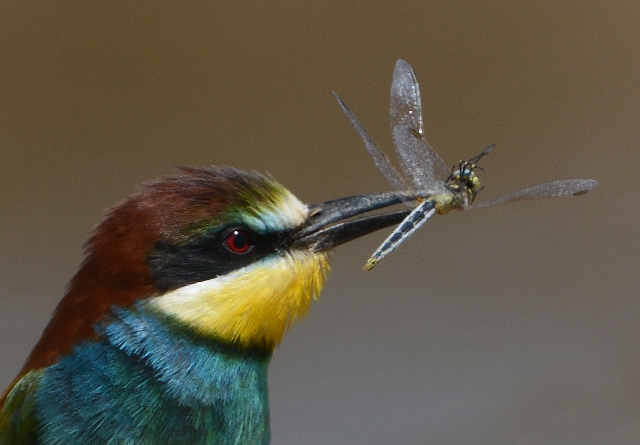European Bee-eater Gallery
Ray Tipper goes in pursuit of one of the Algarve's most iconic visitors
It’s that time of year again in the Algarve. The sun is out, the sky is blue……and European Bee-eaters are busy at the nest sites. Gone are the days when it was possible to hear the excited liquid trills of high-flying migrants moving north. Now Algarve birds are well into their breeding season. Their rainbow colours, sleek appearance and dashing flight ensure they are a huge favourite with visitors to the Algarve. European Bee-eaters, by choice, are faithful to their nesting sites which are occupied year after year unless disturbed or destroyed. On average, colonies are relatively small and usually do not exceed eight pairs. Inevitably, new colonies are established as old ones disappear and this year there are at least three that are active on the outskirts of Tavira. So, I am in the fortunate position of being able to jump in a car and be at any of them within ten minutes.
copy European Bee-eater.jpg)
Above - the fast rising flight of the European Bee-eater as it accelerates in pursuit of aerial insect prey. Picture Ray Tipper: Licence enquiry...
For the bird photographer bee-eaters are a delightful subject. Once at their colonies they habitually hunt from favoured perches to which they return to demolish their prey. Statistically bees and wasps are the preferred food items of European Bee-eaters although they will eagerly catch and devour other large flying insects, especially beetles, butterflies and dragonflies. It is thought they mate for life. Certainly they are paired when they arrive at the breeding colony. Field guides customarily only ever describe adults and do not differentiate between male and female plumage. In fact, with a good view and especially when the breeding pair is perched together, it is usually straightforward to distinguish the sexes. Females have a smaller russet area on the closed wing and sometimes show a narrower black border to the yellow throat which can appear paler than in the male as can the turquoise underparts.

The habit of perching prominently is a massive aid to good portraiture. Picture Ray Tipper: Licence enquiry...
Photographing bee-eaters in flight is a little more tricky, particularly because they tend to fly with the sky as a background and the underwing is in shadow. It is well worth persevering, however, as successful results can be most gratifying.
A European Bee-eater banks in flight to show the multicoloured upperparts. Picture Ray Tipper: Licence enquiry...

This European Bee-eater varies the diet with a Black Percher Diplacopdes lefebvrii. Picture Ray Tipper: Licence enquiry...

The noticeably smaller russet wing-patch distinguishes the bird on the left as a female. Picture Ray Tipper: Licence enquiry...
Ray Tipper, who spends much of his time in the Algarve, is co-author of Algarve Wildlife - the natural year which, since its publication in September 2009, has become the best-selling book for those interested to learn about and see the wonderful wildlife of the region. Ray's intimate knowledge of Portugal and its birds has been recognised by his appointment as a member of the Portuguese Rarities Committee.
Ray leads specialist birdwatching tours all over the world, and since 1997 has led some 80 tours in Europe, North and Central America, Asia and Madagascar. He also accompanies parties on birdwatching and photography trips in and around the Algarve. If you would like to find out more about Ray's trips email here...
Please Help Us: If you have found this information interesting and useful, please consider helping to keep First Nature online by making a small donation towards the web hosting and internet costs.
Any donations over and above the essential running costs will help support the conservation work of Plantlife, the Rivers Trust and charitable botanic gardens - as do author royalties and publisher proceeds from books by Pat and Sue.
copy European Bee-eater.jpg)

